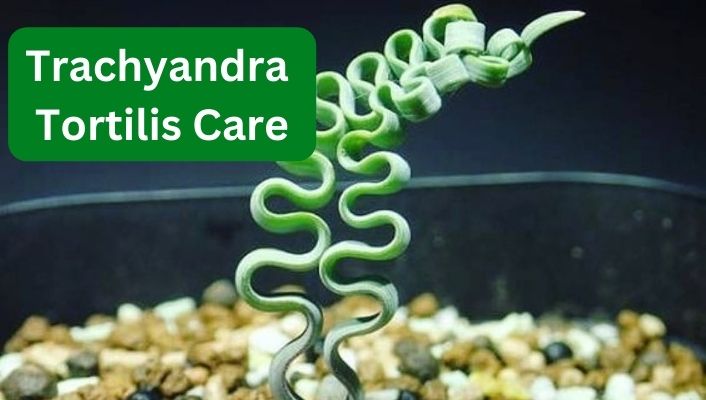The following article will focus on a plant that seems artificial. It is the Trachyandra Tortilis, and it has great and beautiful foliage that curls and makes the plant look alluring and mesmerizing. This plant is rare; you can barely see it in gardening stores, even online.
You should consider yourself lucky if you have one and if you find one because it is rarely available in cultivation either.
Being a succulent plant, Trachyandra Tortilis has a longer life span compared to other species. Their natural habitat is in sandy or rocky soils, and mostly they can be found in riverbeds. This shows their uniqueness. The origin of this plant is South Africa and Madagascar.
Keep reading this article about Trachyandra Tortilis Care and growing guide.
Post Contents
- Basic Information about Trachyandra Tortilis
- Trachyandra Tortilis Appearance and Characteristics:
- Size and Growth:
- Trachyandra Tortilis Care Guide:
- Light Requirements:
- Watering Routine:
- The Right Temperature:
- Air Humidity:
- Soil Mix:
- Should You Fertilize It?
- Propagation of Trachyandra Tortilis:
- Repotting:
- Pruning Routines:
- Frequently Asked Questions:
- Conclusion:
- Author
Basic Information about Trachyandra Tortilis
| Attribute | Information |
|---|---|
| Plant | Trachyandra Tortilis |
| Scientific Name | Trachyandra tortilis |
| Native Region | South Africa |
| Growth Habit | Succulent, herbaceous plant |
| Leaf Shape | Spiral or corkscrew-like |
| Watering Needs | Drought-tolerant |
| Soil Requirements | Well-draining soil |
| Flowering Season | Late spring to early summer |
| Propagation | Can be propagated from seeds or offsets |
Trachyandra Tortilis Appearance and Characteristics:
Trachyandra tortilis immediately captivates the look of the person looking at it through its intriguing appearance. The whole plant is just a perfect example of unique beauty, from foliage to flowers.
As mentioned above, the leaves are curled, coiled or in a spiral form. Moving to the base of the plant, mostly a single flower stalk is produced. This is an exotic plant, and a person having this in his collection should know that he has a masterpiece.
Related Post: Calathea Flamestar Care Tips (For Perfect Growth)
Size and Growth:
Suppose you have limited space to keep this plant, then there is no need to worry about it, as succulents don’t grow too much. The Trachyandra Tortilis can only reach up to 25 cm (10 inches) tall. Besides, its basal leaves could grow to 10 cm (4 inches) in length.
This plant has a long life span, so that you can have a long enjoyment of it. Along with this, Trachyandra Tortilis has an unusually slow growth rate. Remember to plant them in small pots that are eye-catching and cute.
Trachyandra Tortilis Care Guide:
Caring for this exotic beauty can be a little hard and tricky for beginner collectors. It is common among succulents to look extremely healthy; the next day, they can look at a declining rate.
Not to worry, as we have gathered the perfect points so that you can take proper and perfect care of your plant and have no hassles. Let’s get right into it:
Light Requirements:
As we all know, the basic concept is that plants need sunlight to make food. But the ideal light preferences start to vary when discussing different species. The Trachyandra Tortilis needs a bright light, but it should be indirect.
You can easily achieve this by keeping it indoors. Go for a south-facing window for your plant. When light is harsh, you can use a curtain that lets a bit of light through.
Interestingly, you can provide your plant with artificial light sources. If your plant receives less natural light, this can aid in light requirements.
Watering Routine:
You should never overwater this plant. Watering mistakes can disturb the Trachyandra Tortilis care. This plant usually prefers dry soil, as it is succulent. Always remember that the watering of Trachyandra Tortilis needs to be properly regulated.
When dealing with tropical plants, you must be aware of the soak-and-dry method. All you have to do is, when the soil seems dry, water it thoroughly and then drain all the excess water. Let the soil become completely dry before watering again.
Also Read: Calathea Warscewiczii Care & Propagation (Perfect Guide!)
The Right Temperature:
The right temperature is an essential part of this plant’s care. Maintain the temperature range between 5 – 15°C (41-59°F).
High temperatures, either hot or cold, can extremely harm your plant. Keep a check on temperature changes.
Remember that if your plant is in a cold area for a long period, keep it insulated.
Air Humidity:
Succulents don’t want extra moisture in the surroundings. So always keep the humidity at low to medium levels. If possible, keep the humidity at lower levels and keep this plant away from your humidity-loving plants.
As this plant has enough reserve of water for dry conditions, it won’t also need any misting. It grows best in arid surroundings. Try to find a place with low humidity to grow your Trachyandra Tortilis.
Soil Mix:
You can easily find a special kind of potting mix that’s made for succulents and cacti. This will be just right for Trachyandra Tortilis. Moreover, the soil should have good drainage capabilities. The soil mix should be airy and porous.
Besides all this, you should keep the soil with an acidic pH (5.1 – 5.5). You can add peat moss, which helps lower the pH levels. You can buy a pH meter to keep a check. This will help you maintain the nutrients in the soil.
Should You Fertilize It?
Fertilizer isn’t much needed for the growth of Trachyandra tortilis as this plant does not need a lot of nutrients. Surprisingly this plant will grow healthily even if the soil isn’t fertile.
Still, if you want to fertilize it, always choose a balanced fertilizer. We recommend diluting fertilizer and only using it when you feel it is necessary. No doubt fertilizer will help grow lush foliage but don’t make your succulent addicted to it.
Propagation of Trachyandra Tortilis:
As this plant is rare, propagating this exotic plant will make many of these plants. As you know, growing or having it in the first place was a great investment.
Propagation of this plant can be done through seeds and leaf cuttings.
Succulents can be tough to grow from seeds. It can take a year to get it to a desirable size. But there is no flaw in trying. We recommend going for it and growing this beauty.
If you have mature and healthy Trachyandra Tortilis, you can cut vigorous leaves and let them develop. Then plant them as you desire, and remember to water a lot.
Repotting:
This plant is very slow-growing, so maybe you won’t require repotting until two years. Remember that succulents usually like to be pot-bound. Trachyandra Tortilis also prefers the same thing.
Repotting is usually simple, take it out of its current container. Free the roots from the current potting soil. Only trim the roots if it’s needed. Only repot if the plant is outgrowing its container. Use a larger pot or container when repotting.
Pruning Routines:
The Trachyandra Tortilis is succulent, and it does not need any pruning. You have to let its foliage grow thick. But we recommend pruning the roots during repotting. As told above, you can cut off dead and rotten portions of the root system.
Frequently Asked Questions:
What is Trachyandra Tortilis?
Trachyandra Tortilis is a succulent plant. It’s a unique and rare species popular for its attractive appearance.
Does Trachyandra Tortilis have a common name?
Yes! The common name of the Trachyandra Tortilis is ribbon plant.
How do you grow Trachyandra Tortilis from seeds?
You can use the seeds of Trachyandra Tortilis for propagation. You shouldn’t miss the chance to multiply these beauties.
Is Trachyandra Tortilis toxic?
This succulent species is totally safe to humans and pets. Trachyandra Tortilis is considered non-toxic and non-harmful even when ingested.
Conclusion:
And that’s a wrap! Hope you have got answers to a lot of your questions and you might now be planning to get this plant. Make sure to follow all the important steps of Trachyandra Tortilis care.
The above specialized guide article will surely help you in taking good care of your Ribbon plant. We recommend somehow getting one, as it will make your collection a unique one.
Read More Articles:
Black Strawberries Exists? (Here’s What You Should Know)

